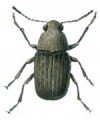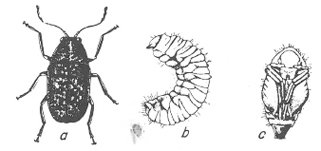

Latin: Araeocerus fasciculatus.
This small, dark brown beetle is known primarily from stocks of unroasted coffee beans. It is common in tropical and subtropical coastal countries, and can also be seen in corn, cocoa, nutmeg and the seeds of leguminous plants. It requires food that is not too dry. The water content must be equal to 65% RH and preferably a little more than that. The larvae live inside the coffee beans and turn them rotten. As the coffee bean weevil cannot complete its development from egg to adult at temperatures below 22 ° C, it will usually die out by itself when the beans arrive to this country. At 28-32 ° C, the coffee bean weevils increase their number 40 times over the course of a month, so if infested beans are stored in warm storages the weevils will do significant damage. In the old days it was almost a virtue of necessity to claim that rotten beans gave a particularly tasty coffee.
The weevils and their larvae will not survive the coffee bean roasting, and the damage done by these weevils should probably rather be considered from an economic perspective (weight loss during storage) than from hygienic-culinary beliefs.
The coffee bean weevil is actually not a bean weevil, but belongs to a family that stands near the true weevils. Therefore, it is not subject to the restrictions relating to bean beetles.




